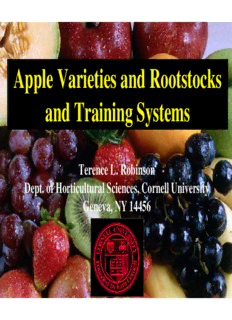
Dr. Terence Robinson's 2006 VTFGA presentation on Apple Varieties and Rootstocks PDF
Preview Dr. Terence Robinson's 2006 VTFGA presentation on Apple Varieties and Rootstocks
Apple Varieties and Rootstocks and Training Systems Terence L. Robinson Dept. of Horticultural Sciences, Cornell University Geneva, NY 14456 What is the Future of the Apple Industry? Should We Replant and Continue to be a Player, or become a Former Player? The Opportunity: • Well managed new planting systems mean early production and high mature yields. • Exciting new varieties on the horizon from breeding programs. • New technologies will improve fruit quality. • Low interest rates. Successful Apple Businesses • Have products (varieties) that people want. • Develop new markets for their products. • Efficient producers. • Develop new products (varieties) that are in greater demand while eliminating products (varieties) that have poor demand. • Eliminate poor performing blocks. • Willingness to change as markets change. Cornell Recommendations • Each fruit farm needs to be on a continual replanting program to remain competitive over the long term. • Replanting allows farms to eliminate poor performing blocks and develop new higher yielding blocks. • Replanting allows farms to develop new products (varieties) that are in greater demand while eliminating products (varieties) that have poor demand. • We recommend that 4-5% of the farm be replanted annually. The Problem: What to Plant? • The marketers want the traditional varieties (McIntosh, Empire, Delicious) that they can sell. However, these often are sold for $4-6 per carton. • Newer varieties often generate higher fruit prices for the first few years but they are more difficult to market. Thus they are riskier. • Occasionally a new variety generates very high fruit prices. e.g. Honeycrisp. What to Plant? • To minimize risk, plant the best of the wholesale varieties on 50% of new orchards. – McIntosh - – Empire - Royal (with MCP) – Gala - – Cortland (with MCP) • To generate high returns, plant niche varieties that have high fruit prices on 40% of new orchards. – Honeycrisp – Jonagold -(with MCP) – Macoun – Fuji - early strains – Gingergold (with MCP) • Gamble for very high returns on a small acreage (10%) – Ambrosia, Cameo, Pacific Rose, Pinata, Topaz etc. Some Suggestions: Direct Marketing Pristine Zestar! Ginger Gold Sansa Golden Supreme Gala strains to spread maturity Honeycrisp NY674 McIntosh: strains to spread out maturity Cortland- Royal Court Macoun Empire Jonagold-Rubinstar, Decoster Sonata Ambrosia BCVariety: 8S-27-43 Cameo Fuji: Auvil Early,Sept. Wonder Fortune Braeburn: earlier strains Granny Smith Goldrush Topaz Hampshire Pinova (Pinata) Suggestions: Wholesale Market: • Zestar! (to replace Paula Red) • Gala striped strains to spread maturity • NY 674 • Honeycrisp • McIntosh – Linda Mac / Acey Mac • Cortland -Royal Court. Redcort • Sonata • Jonagold Rubinstar Decoster • Royal Empire • Ambrosia • Cameo • Braeburn –earlier strain • Fuji – earlier strain Another Problem: What Rootstock to Plant? • Rootstock performance varies around the country. • There is great disparity of opinion on the optimum planting density.
Description: